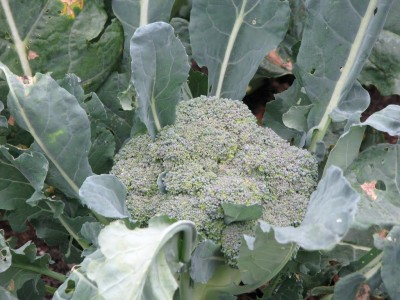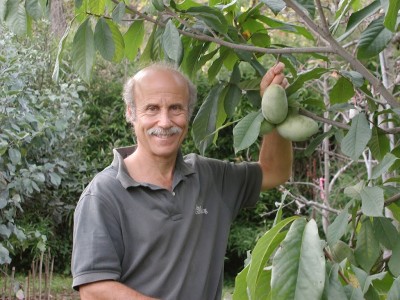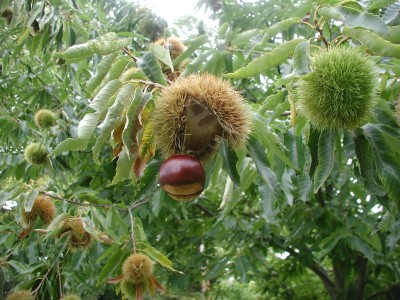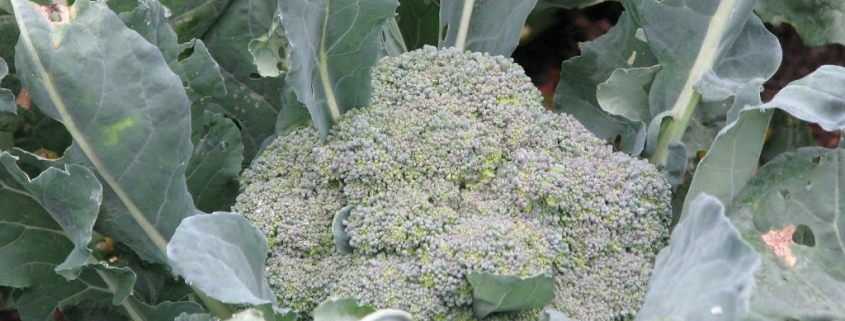[broccoli, uncommon fruits, nuts]
A few months ago I wrote that I once saw eye to eye with ex-President Bush – that was H. W. Bush, and we saw eye to eye about broccoli. Neither of us thought much of broccoli, in my case, it was my own, home-grown broccoli that failed to please.

This year I thought I’d make a real effort to grow good broccoli to see if perhaps I could effect an about face. The crop from my first planting was awful. I persevered with a second planting, sown in seed flats in June, for a fall crop. I gave each plant adequate spacing (2 feet apart in the row, 2 rows per 3 foot wide bed), planted them in soil enriched with soybean meal and an inch depth of compost, and kept an eye out for cabbage worms. The heads have been ripening in this cooler weather, and I’ve been making sure to harvest while the buds are still tight.
All this effort has paid off: The broccoli is delicious. Bush, you’re wrong.
*************************************
Home-grown apples can be quite delicious. That is, if you get to harvest any decent fruits, which you likely will not do if you grow apples east of the Rocky Mountains. Over much of the eastern U.S., apples have a few but very serious pest problems. If you don’t spray appropriate materials at just the right moments (note the plural), you usually do not get anything worth eating.

Which brings me to the workshop I held last weekend on backyard fruits. I suggested growing fruits that have few or no pest problems, preferably those that don’t even need the precise, annual pruning demanded by apple trees. To whit: For some easy to grow tree fruits, consider pawpaw, American persimmon, and/or medlar. They all have unique flavors reminiscent of, respectively, banana, apricot, and applesauce. Plus, they require no spraying and little or no pruning. All are quite ornamental, so do double duty as landscape plants also.
A couple of other fruits were also ripe for discussion and tasting. Hardy kiwifruits, everyone agreed, were delicious, similar to but sweeter and more flavorful than the fuzzy kiwifruits of the market. They’re grape-sized with smooth skins and you just pop them, whole, into your mouth. They are also easy to grow except that they must be pruned religiously unless you don’t mind them smothering an arbor or trellis, with the subsequent fruit becoming hard to pick.
Another tasty fruit now ripe, this one on a shrub, is – dare I mention it – autumn olive. Yes, I know it’s very invasive. On some bushes, the pea-sized fruits have lost their astringency and are very tasty. With silvery leaves, autumn olive is also quite ornamental.
All these fruits are among those dual purpose “luscious landscape” plants I describe in my book Landscaping with Fruit.
********************************************
We also saw some beautiful nuts – trees and shrubs, that is – at the workshop. First were filberts, also known as hazelnuts. I’ve grown both the American and European types. I no longer grow the American types, which are native to eastern U.S., because, although resistant to filbert blight, the nuts are small and somewhat bitter. However, their leaves turn a beautiful color in autumn.

European filberts bear large, tasty nuts. Blight resistant varieties of European filberts were recently developed, and they grow to make large shrubs whose stems arch out from the base of the plant like a fountain of water. I grow the varieties Santiam, Hall’s Giant, Lewis, and Clark, all bearing within 3 years of planting.
And finally we came to chestnuts, another nut with its own blight. This blight was introduced from Asia. American chestnuts are killed back by chestnut blight but resistance and tasty nuts are found in Asian chestnut species. I grow a few varieties of Asian hybrids, including the variety Colossal and a seedling, both of which bore within 5 years of planting, and the varieties Peach and Eaton, which are still young.
Chestnuts are beautiful, spreading trees with healthy looking, glossy green leaves that will soon turn a rich, golden color. Every day now I pick up golfball-sized, buffed brown nuts that drop from Colossal’s branches.




Hello from Oregon, fellow Lee!
Hello to you! Do you go . . .er, grow nuts in you very nice growing climate?